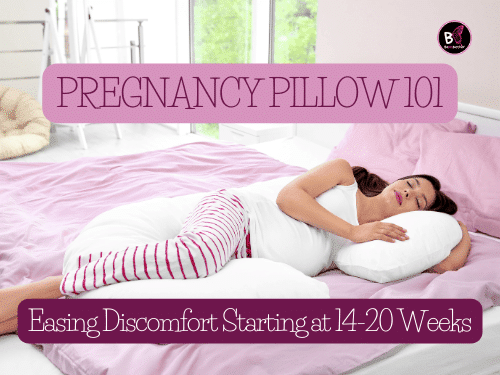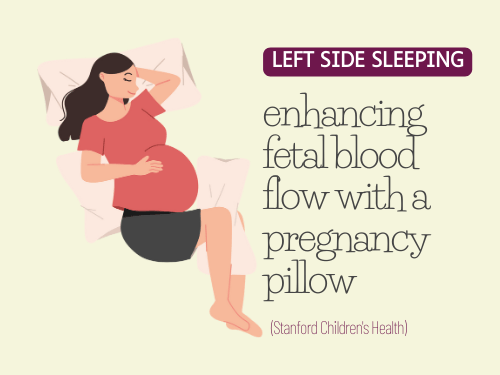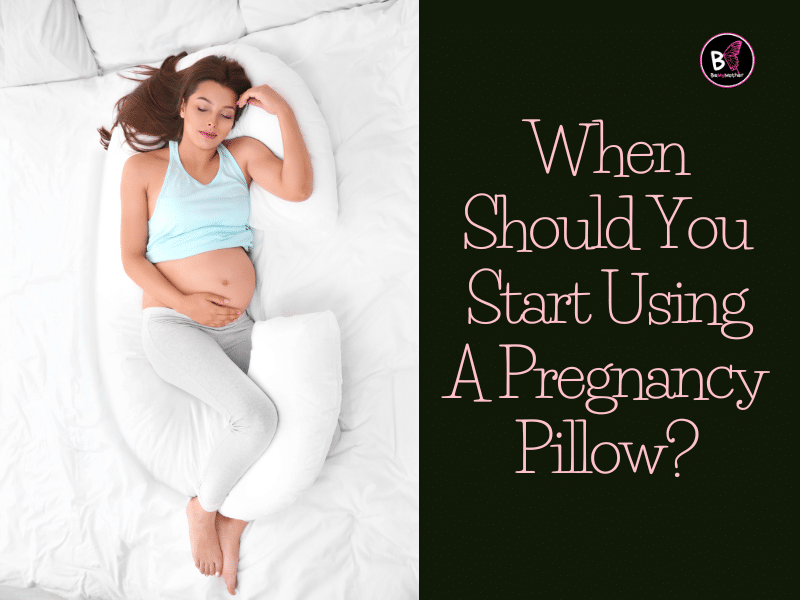Pregnancy is an exciting journey, but it also comes with physical challenges, particularly when it comes to sleep and comfort. A pregnancy pillow can be a game-changer, offering much-needed support as your body changes. But when should you start using a pregnancy pillow, and how do you maximize its benefits? This comprehensive guide will cover everything from the ideal time to start using a pregnancy pillow to the benefits, types, and tips for effective use.
1. When Should You Start Using a Pregnancy Pillow?
Most women use a pregnancy pillow during the second trimester, typically around 14-20 weeks, when the baby bump grows, and discomfort becomes noticeable. Back pain, hip pressure, and trouble finding a comfortable sleeping position are common signs that it’s time to introduce a pregnancy pillow into your routine.
🔍 Research Insight: According to the University of Auckland‘s “Sleep on Side; Stillbirth Prevention Campaign,” it is recommended that pregnant women start using a pregnancy pillow around their second trimester (approximately week 20) to alleviate back pain and enhance sleep quality. Source: University of Auckland Sleep on Side
2. What Week Should You Start Using a Pregnancy Pillow?

For many women, discomfort starts becoming more evident by week 16-20, although it can vary. Hormonal changes, weight gain, and the growing uterus shift the body’s center of gravity, which affects posture and sleep positions.
- Early Second Trimester: Light discomfort may arise, especially for those with preexisting back pain.
- Late Second Trimester: As the belly expands, the need for additional support intensifies.
This gradual progression highlights why pregnancy pillows become essential during the second trimester.
💡 Related Article: Experiencing discomfort in your feet as your pregnancy progresses? Discover practical solutions in How to Relieve Foot Pain During Pregnancy? 9 Proven Tips Every Mom-to-Be Should Know. Take steps toward a more comfortable journey.
3. Benefits of Using a Pregnancy Pillow
Pregnancy pillows provide several benefits, making them a worthwhile investment:
- Improved Sleep Quality: Promotes better alignment and reduces tossing and turning.
- Pain Relief: Reduces strain on the back, hips, and knees.
- Belly Support: Supports the growing bump to prevent pressure and discomfort.
🔍 Research Insight: A study published in the International Journal of Global Health and Research found that the use of maternity pillows significantly improved sleep quality among women in their third trimester. Participants reported reduced back and pelvic pain, leading to more restful sleep.
Source: Global Health Science Journal
4. Common Sleep Disorders and Problems During Pregnancy
Pregnancy can exacetrbae sleep issues, including:
- Insomnia: Hormonal changes and physical discomfort disrupt sleep cycles.
- Sleep Apnea: Increased weight and nasal congestion can lead to breathing difficulties.
- Restless Leg Syndrome: Affects many pregnant women, causing leg discomfort.
Pregnancy pillows help address these issues by providing support and improving blood flow, making sleep more restful.
💡 Related Article: Wondering if pregnancy could change the size of your feet? Discover the facts and common myths in Do Feet Grow During Pregnancy? 10 Shocking Facts That Bust Common Myths. Learn how your body might adapt during pregnancy.
5. Types of Pregnancy Pillows: Which Shape Is Best for You?
Pregnancy Pillow – Benefits, Types, and How to Use
There are various pregnancy pillow shapes designed to meet specific needs:
| Pillow Type | Best For |
| U-Shaped | Full-body support, ideal for back sleepers. |
| C-Shaped | Side-sleepers need belly and back support. |
| Wedge | Targeted belly or back support. |
| Full-Body | Complete head-to-toe support. |
🔍 Research Insight: WebMD highlights various types of pregnancy pillows, including C-shaped, U-shaped, wedge, and full-body pillows. The choice depends on individual needs, such as targeted support for the back, belly, or hips and preferred sleeping positions.
Source: WebMD
6. Tips for Using a Pregnancy Pillow Effectively
Maximize comfort of your sleep with these tips:
- Positioning: Place the pillow under your belly for support or between your knees to relieve hip pressure.
- Adjust as Needed: As your pregnancy progresses, adjust the pillow to support different areas.
- Combine with Other Supports: Pair with regular pillows for additional comfort.
Proper use of a pregnancy pillow can significantly improve your sleep experience during pregnancy jouney.
💡 Related Article: Interested in staying active while ensuring your safety during pregnancy? Explore safe exercise tips in Planks During Pregnancy: 10 Expert Tips for Safe and Effective Workouts. Stay fit and comfortable throughout your pregnancy.
7. Is 14 Weeks Too Early to Start Using a Pregnancy Pillow?

No, starting at 14 weeks is not too early. Many women find relief even in the early second trimester, especially if they experience back pain or sleep disturbances. Using a pregnancy pillow early can help your body adapt to the physical changes ahead.
8. Best Sleeping Positions with Pregnancy Pillows
The best sleeping position during pregnancy is side-sleeping, preferably on the left side. This position improves blood flow to the fetus and reduces pressure on vital organs. A pregnancy pillow can help maintain this position by supporting the back, belly, and legs.
- Side-Sleeping: Wrap the pillow around your body for full support.
- Avoid Stomach or Back Sleeping: These positions can become unsafe as the uterus grows.
🔍 Research Insight: According to Stanford Children’s Health, sleeping on the left side is recommended during pregnancy to enhance fetal blood flow and improve kidney function. Utilizing a pregnancy pillow can help maintain this position comfortably throughout the night.
Source: Stanford Children’s Health
9. Fabric, Filling, and Organic Options for Pregnancy Pillows
Choosing the right pregnancy pillow involves understanding the materials and fillings that best suit your needs:
- Hypoallergenic Fabrics: These are ideal for individuals with sensitive skin or allergies, providing a gentle and safe option.
- Memory Foam: Offers customized support by contouring to your body shape, helping to alleviate pressure points and improve sleep quality.
- Organic Cotton: A natural, eco-friendly choice, free from harmful chemicals, making it safe for you and the environment.
When selecting a pregnancy pillow, consider your comfort preferences, sensitivities, and commitment to sustainable, toxin-free materials to ensure restful and worry-free sleep.
💡 Related Article: Struggling to find the best ways to support your growing belly and relieve discomfort? Learn expert advice on improving your posture and easing back pain in How to Wear a Pregnancy Belt: 8 Exquisite Tips for Comfort for a more comfortable pregnancy experience.
10. Ways to Use a Pregnancy Pillow After the Baby is Born
Pregnancy pillows remain incredibly useful even after childbirth, offering versatile benefits for moms:
- Nursing Support: Elevates the baby to a comfortable position during feeding.
- Postpartum Recovery: Provides support for the back and abdomen.
- Body Pillow: Serves as a cozy option for general relaxation.
Repurposing your pregnancy pillow ensures continued value long after pregnancy.
11. When Do You Need to Stop Sleeping on Your Stomach While Pregnant?

Sleeping on your stomach becomes uncomfortable and unsafe as the uterus expands in the second trimester. The growing belly makes it challenging to maintain this position without causing strain or discomfort.
Transitioning to side-sleeping with the help of a pregnancy pillow is a safe and comfortable alternative.
🔍 Research Insight: Healthline advises that sleeping on the stomach becomes uncomfortable and potentially unsafe sleeping on the stomach becomes uncomfortable and potent Transitioning to side sleeping with the support of a pregnancy pillow is recommended to ensure maternal and fetal well-being.
Source: Healthline
FAQ Section
- When should you start using a pregnancy pillow?
It’s ideal to use a pregnancy pillow during the second trimester, around 14-20 weeks, when your belly starts growing and discomfort begins. - Do pregnancy pillows actually help?
Yes, pregnancy pillows support the back, hips, and belly, reducing pain and improving sleep quality. - Which shape pregnancy pillow is best?
It depends on your needs: U-shaped and C-shaped pillows offer full-body support, while wedge pillows are great for targeted support. - When should I stop sleeping on my stomach while pregnant?
By the second trimester, sleeping on your stomach becomes uncomfortable and unsafe. Transition to side-sleeping with the help of a pregnancy pillow. - Why can’t I sleep on my right side while pregnant?
Sleeping on your left side is often recommended to improve blood flow to the baby, but sleeping on your right side is generally safe unless advised otherwise by your doctor. - Can a pregnancy pillow help prevent back pain?
Yes, pregnancy pillows support proper alignment, reduce pressure on the back and hips, and help prevent or alleviate pain. - What is the best time to buy a pregnancy pillow?
You can buy a pregnancy pillow when you experience discomfort or anticipate needing extra support, typically early in the second trimester. - Am I crushing my baby when I sleep on my side?
No, side-sleeping is safe and recommended during pregnancy. A pregnancy pillow can help you maintain a comfortable position.
Conclusion
Pregnancy pillows are more than just a comfort item—they’re essential for improving sleep and relieving discomfort. Knowing When Should You Start Using a Pregnancy Pillow, typically during the second trimester, prepares you for the physical changes ahead. With proper use, a pregnancy pillow can help you sleep better, support your growing belly, and even serve a purpose postpartum. Investing in the right pillow ensures comfort and support throughout your pregnancy journey.
💡 Related Article: Curious about using skincare products while expecting? Learn more in Is Bio-Oil Safe During Pregnancy? 8 Essential Facts Expecting Mothers Need to Know. Make informed choices for your skincare routine.



